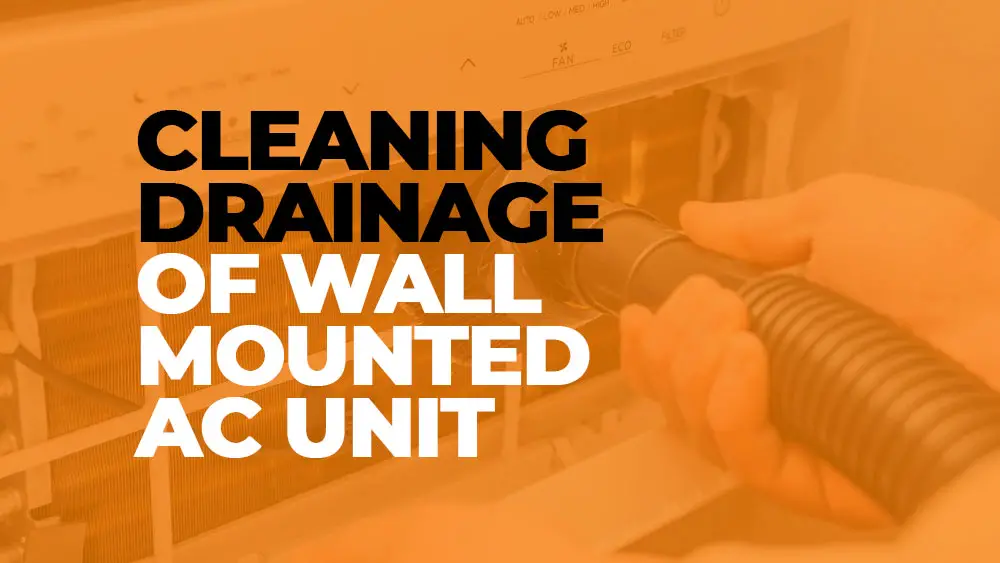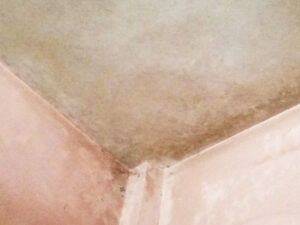Hello there! As an experienced HVAC technician, I understand the significance of proper maintenance for wall-mounted AC units. A key aspect of maintenance involves keeping the drainage system clean to ensure optimal performance and prevent issues like water leakage or reduced cooling efficiency.
Wall-mounted air conditioners are an efficient and simple solution for cooling individual rooms or small areas in homes and commercial buildings alike. As with any HVAC system, wall-mounted AC units need regular attention in order to perform at their best.
Cleaning the drainage of a wall-mounted AC unit may seem daunting at first, but with the proper approach and tools it can become straightforward and effective. In this article, I’ll share my expertise on how to effectively and efficiently maintain its drainage system, from gathering materials for cleaning to the actual removal of dirt from its drain lines.
So let’s dive in and learn how to properly clean the drain of a wall-mounted AC unit to ensure its optimal functioning and efficient running.
Why Is Drainage Cleaning Necessary?
Wall-mounted air conditioning units rely on their drainage system for extracting condensation produced when warm air passes over an evaporator coil, collecting it in a drain pan before draining away through an approved drainage pipe or hose. Over time, dirt, dust, and debris can accumulate in the drainage system, leading to clogs that obstruct the flow of water, overflowing it and potentially damaging either your unit or the surrounding environment. Clogged drainage can provide the ideal environment for mold, mildew, and bacteria growth that threatens indoor air quality and poses health risks, so regular drain cleanings must take place to avoid clogs, water damage, and potential health hazards.
What Tools and Materials Will You Require to Complete the Job
Before beginning to clean the drainage of a wall-mounted air conditioning unit, gather these tools and materials:
- Screwdriver: In order to access the drainage components and remove the front cover of your AC unit, a screwdriver will be needed.
- Vacuum cleaner: To remove dust and debris from the drainage pan and pipe system, invest in a vacuum cleaner equipped with a hose attachment.
- Cleaning solution: When it comes to drain cleaning components, a combination of water and mild detergent should do just fine.
- Soft Brush: For optimal cleaning results, using a soft brush such as a toothbrush or small cleaning brush to clean out both the drainage pan and pipe can be extremely helpful.
- Bucket or towel: In order to collect water and debris during the cleaning process, you will require either a bucket or towel.
- Safety goggles and gloves: For optimal cleaning results, always wear safety goggles and gloves during the cleaning process to protect yourself against dirt, debris, or cleaning solutions that could come into contact with your skin.
Step-by-Step Guide to Maintaining Wall-Mounted AC Unit Drains

Step 1: Switch Off and Unplug the AC Unit
Before beginning to clean the drainage of a wall-mounted AC unit, always ensure it has been switched off and unplugged from its power source. This step will ensure your safety as you work on it as well as protect against accidental damages to its components or electrical hazards.
Step 2: Remove the Front Cover
To gain access to the drainage components of a wall-mounted AC unit, it will be necessary to first remove its front cover. Use a screwdriver carefully unscrew and pull away from this front cover; place its screws somewhere safe so as not to lose them!
Step 3: Clean Drainage Pan
Once the front cover has been removed, you will be able to see the drainage pan that sits underneath the evaporator coil. Use a vacuum cleaner with a hose attachment to eliminate dust, dirt, and debris in the drainage pan – paying particular attention to corners and edges where dirt accumulates. For any stubborn stains or residue in the drainage pan that requires special attention, soft brushes dipped in cleaning solution may help gently scrub it clean before thoroughly rinsing with water so as to eliminate any cleaning solution residue left behind after.
Step 4: Clean the Drain pipe or Hose as soon as possible.
Drain pipes or hoses are essential in transporting condensed water from drainage pans to an outside location for disposal but can become clogged over time with dirt, dust, and debris that impedes the flow of water. Use a vacuum cleaner with a long flexible brush attachment, such as one available from Amazon, to clear away dirt or debris in your drain pipe or hose before inserting a vacuum hose into it to thoroughly clear debris out; use a plumber’s snake or pipe cleaner if the blockage persists if necessary before thoroughly rinsing it with water afterward to ensure smooth water flow of water out. Once finished rinse it thoroughly with water to ensure smooth water flow!
Step 5: Test Drainage Tray and Hole for Completeness.
Under some wall-mounted air conditioner units may be a drainage tray or drip pan that collects excess condensation. Check this tray or drip pan for dirt, debris, or standing water, and use either a vacuum cleaner or soft bristled brush dipped in a cleaning solution to clean it if needed. Also, ensure the drainage hole in the tray or pan is not blocked by using either a small brush or pipe cleaner to clear away the debris that obstructs proper drainage.
Step 6: Reassemble the AC Unit
Once your drainage pan, drain pipe/hose, and drainage tray have been thoroughly cleaned it’s time to reassemble your AC unit. Carefully attach the front cover back onto the unit using screws removed earlier; ensure its security before tightening them with screws from earlier. Check that there are no air or water leaks through it!
Step 7: Plug and Turn On the AC Unit
Once your air conditioning unit has been assembled and assembled back together, plug it back into its power source and turn it on. Allow it to run for several minutes to ensure the proper functioning and no drainage system leakage issues exist. Make sure to inspect both its drainage pan and drain pipe or hose for signs of water leaking through and immediately turn off the AC unit in order to inspect and correct it as soon as possible. If leakage issues appear, quickly stop running it before taking appropriate action against any possible solutions.
Step 8: Committed to Regular Maintenance and Cleanliness
To maintain proper operation and prevent future drainage system clogs, it’s crucial to perform regular maintenance and cleaning on your wall-mounted AC unit. Here are some helpful hints for preventative upkeep:
- At least once each month during peak cooling season when AC units are frequently being used, ensure you clean out the drainage pan and drain pipe or hose to the drain pit or cistern to keep everything functioning smoothly.
- Check your drainage tray and hole regularly for signs of dirt, debris or standing water, and clean as necessary.
- Use a mild detergent or cleaning solution to clean drainage components, then thoroughly rinse with water to eliminate any residue left by cleaning solutions.
- Examine your drainpipe or hose for signs of cracks, leaks, or damage and repair or replace as required.
- Keep the area around your AC unit clean to prevent dirt, dust, and debris from entering into its drainage system.
- Consider purchasing a condensate drain pan treatment or tablet that helps prevent mold, mildew, and bacteria growth in your drainage system.
How often should I have my wall-mounted air conditioning unit’s drainage cleaned out?
When should you clean the drainage of a wall-mounted AC unit, depending on factors like climate, usage patterns, and overall maintenance? As a rule of thumb, cleaning should occur every three to six months as recommended by manufacturers.
Wherever high humidity or heavy usage exists, drainage systems can quickly accumulate dirt, dust and debris which could eventually clog them. Therefore, more frequent cleaning may be required in such circumstances to maintain the optimal performance of these drainage systems. Likewise, in coastal regions with saltwater corrosion of drainage systems, more frequent cleaning may also be required to keep their performance at its optimal best.
Regular visual inspections can help you quickly determine if the drainage system requires cleaning. If there are signs of water leakage, reduced cooling efficiency or strange sounds coming from your AC unit, these could all indicate a blocked drainage system requiring immediate attention.
Remember that proactive maintenance is the key to keeping your wall-mounted AC unit operating efficiently and avoiding clogs. By regularly cleaning out its drainage system and scheduling professional HVAC maintenance appointments, regular drainage system cleaning will extend its lifespan while saving on costly repairs over time.
What are some common mistakes to avoid when cleaning out the drainage of a wall-mounted AC unit?
Wall-mounted air conditioner units require regular drainage maintenance to stay functional and operate optimally, which involves inspecting their drainage for potential mistakes that could cause damage or reduce the effectiveness of cleaning. Here are some mistakes you should avoid when performing this task:
Do not use harsh chemicals: When cleaning the drainage system of your AC unit, avoid using strong chemicals like bleach or abrasive cleaners as these could potentially damage plastic and metal components and lead to corrosion or leaks in its components.
Neglecting Safety Measures: Always prioritize safety when cleaning the drainage system. Turn off and unplug the AC unit from the power source in order to avoid the risk of electric shock and wear protective gloves and goggles to shield you from cleaning solutions or debris that might get in.
Overlooking the Condensate Pan: To maintain an efficient drainage system, the condensate pan is an essential part. To maintain the optimal functioning of this component, ensure it is cleaned regularly by removing any dirt, algae, or debris that has been collected in it.
Not checking the drain line: The drain line connects AC units to outside drainage systems and should remain free from dirt or debris accumulation over time. Be sure to regularly inspect it for potential clogs using methods such as pipe brushing or flushing it with water in order to clear away any possible blockages that might form in it.
Avoid Over-Fleshing: For optimal cleaning results, utilize gentle cleaning methods when cleaning your drainage system to avoid damage to its delicate components. Soft brushes or cloths may help in safely wiping away the grime in the drain pan, coil or other parts.
Skipping Regular Maintenance: Simply cleaning the drainage system alone won’t do; regular maintenance tasks like changing air filters or scheduling professional HVAC maintenance must also be performed for optimal performance of your AC unit. Failing to do so could lead to ongoing issues with drainage.
Reassembling improperly: After cleaning your drainage system, ensure all the components are reassembled properly and securely. Neglecting to do this could result in leaks or inefficiencies within the drainage system.
By avoiding these common errors and following proper cleaning and maintenance procedures, you can ensure your wall-mounted AC unit’s drainage system stays clear and efficient, helping ensure optimal performance while prolonging its lifespan.
Can I avoid clogs in my wall-mounted AC unit’s drainage?
Yes, preventive measures can help to lower the risk of drainage system clogs on wall-mounted AC units. Here are a few strategies that may help:
As part of your routine maintenance schedule, ensure that you regularly clean the drain system of your AC unit – this includes inspecting its drain pan, coil, and line for dirt, dust and debris that could build up and lead to clogs.
Use a Condensate Pump: If your wall-mounted AC unit is installed in an inaccessible location without an adequate slope for drainage of condensate water, consider investing in a condensate pump to effectively pump out condensation from your drain pan and prevent any pooling that might otherwise pool and cause clogs.
Install a Drain Line Trap: Fitting a drain line trap can help prevent debris and dirt from entering the drainage system and leading to clogs. A trap acts as a barrier by trapping solid particles before they enter it.
Maintain a clean surrounding: To maintain optimal performance of your wall-mounted AC unit, ensure the area around it remains clear of debris such as leaves or vegetation that may block drain lines and lead to blockages within your drainage system. This may prevent potential clogs in its functioning system and improve performance overall.
Use a drain line cleaning solution: Regular use of a drain line cleaning solution can help prevent build-ups of algae, mold, and other contaminants in the drain lines reducing the risk of clogs. Always follow manufacturer instructions for safe and effective application of cleaning solutions.
Schedule professional maintenance: Regular professional maintenance of your AC unit, such as inspecting and cleaning out its drainage system, can help detect potential clogs before they become major issues. A trained technician can also ensure that its functioning correctly as well as make recommendations for preventive measures to take against potential problems in future.
Follow these preventive measures to reduce the risk of drainage clogs in your wall-mounted AC unit and preserve its optimal performance, guaranteeing efficient cooling while increasing its lifespan.
Are there any specific considerations when cleaning the drainage of a wall-mounted AC unit located in humid or coastal regions?
Yes, if you live in a humid or coastal environment there are certain considerations you should keep in mind when cleaning the drainage of your wall-mounted AC unit. High humidity levels and proximity to the coast can impact its performance and maintenance requirements, which in turn could have an effect on its drainage system. Here are a few points worth keeping in mind:
Increased Risk of Algae and Mold Growth: Humid environments increase the chances of algae and mold growth in your AC unit’s drain pan and drain line, which may clog it and reduce the efficiency of the drainage system. Regular cleaning with drain line cleaning solutions specifically tailored to prevent this issue may help alleviate it.
Saltwater exposure: If you live near a coastal region, your AC unit could be exposed to saltwater or air that contains high amounts of salt. Overexposure to salt can damage drainage system components and corrosion; regular rinsing with fresh water will help remove salt residue and prevent corrosion in drain pans and coils as well as prevent further corrosion of other parts.
Debris Accumulation: Coastal areas may experience higher amounts of airborne debris like sand, dust and leaves which can accumulate in drain pans and lines and eventually cause clogs. Regular inspection and cleaning of drainage systems as well as keeping surrounding areas free from clutter can help mitigate accumulation.
Professional Maintenance: Due to the unique environmental challenges present in humid or coastal regions, it is strongly advised to arrange regular professional maintenance of your AC unit, including thorough cleaning and inspection of its drainage system. A trained technician can offer personalized attention tailored to meet the challenges specific to your location.
Rust Prevention: For coastal areas exposed to saltwater, taking rust prevention steps can be crucial in protecting metal components of drainage systems from corrosion. Applying rust-inhibiting coatings or using materials resistant to rust can extend the lifespan of AC units while helping prevent corrosion altogether.
Take special consideration and preventive steps to ensure the drainage system of your wall-mounted AC unit remains clean and efficient, even in humid or coastal climates, and to extend its lifespan.
How to Fix Wall Air Conditioner AC Water Leak
Final Thoughts
For optimal performance and longevity of a wall-mounted AC unit, regular drainage system cleaning is absolutely crucial to its functionality and long-term health. Clogged drainage can lead to water leakage, decreased cooling efficiency, or even damage. By following the steps outlined herein and performing regular maintenance checks on your unit’s drainage system, you can keep its drainage clean and fully operational.
Always prioritize safety when cleaning or maintaining an AC unit’s drainage system. Shut off and unplug it from its power source before beginning any cleaning or maintenance activities, using appropriate cleaning solutions, tools, and protective gear such as gloves and goggles, and wearing safety glasses to avoid potential harm to yourself or anyone else.
As part of regular professional maintenance for your wall-mounted AC unit, it’s also crucial that you set aside time for professional inspection and cleaning of its internal components – including its evaporator coil, condenser coil, and blower – by an HVAC specialist. They will inspect and clean these crucial elements to ensure maximum performance and efficiency of your air conditioning system.
Maintaining your wall-mounted AC unit and its drainage system can extend its lifespan, enhance performance, and lower energy costs – so be sure to add this task into your regular home maintenance routine for maximum comfort indoors for years. With proper care and cleaning procedures in place, you can look forward to enjoyable indoor air quality for many years ahead.







